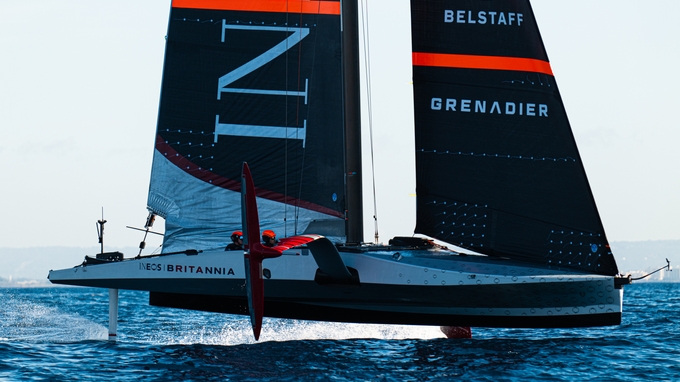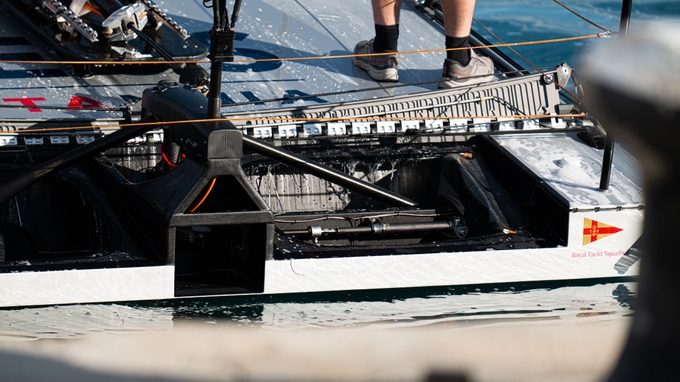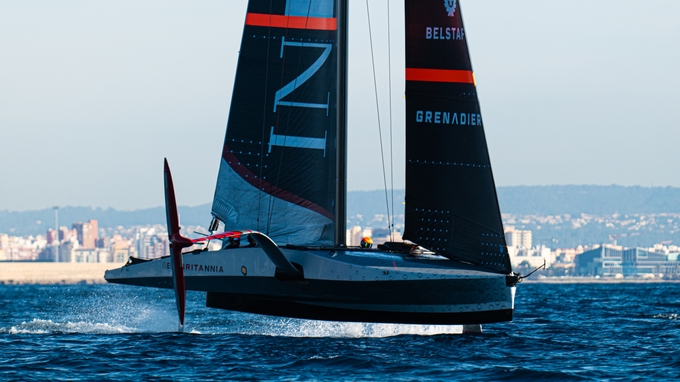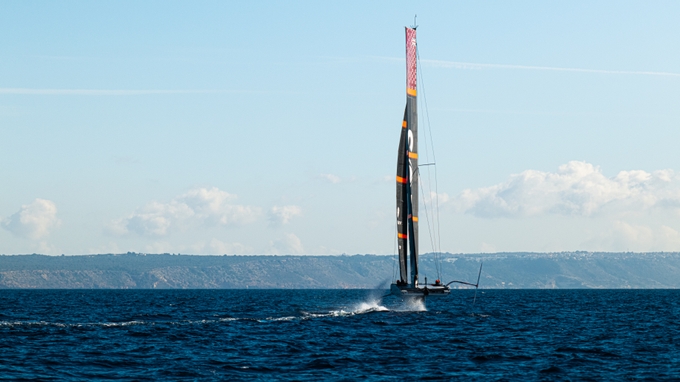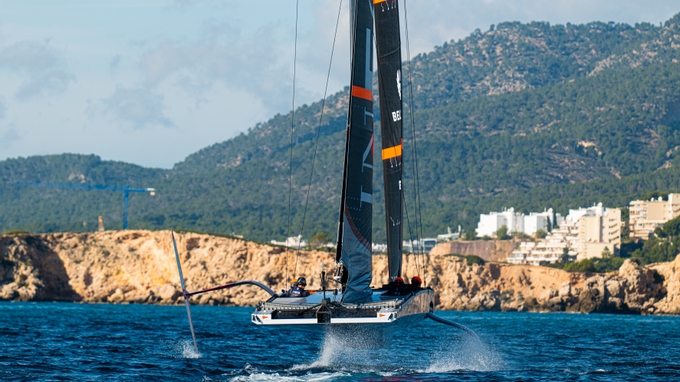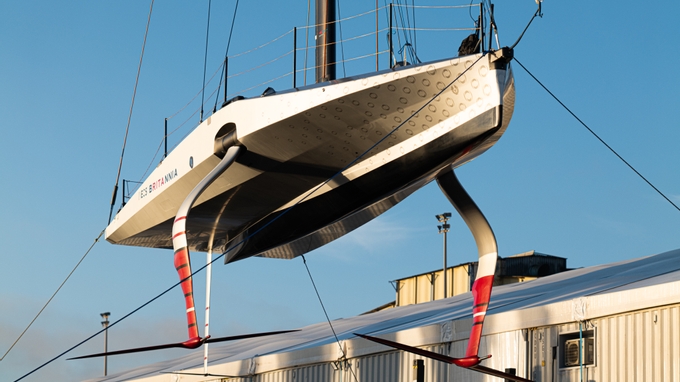POPPING UP IN PALMA
When INEOS Britannia decided to adopt the Bay of Palma as their winter training base, today was the kind of the day that everyone had pictured in their mind’s-eye. Sunny with barely a cloud in the sky, a solid 12-13 knots and Barcelona-type waves that could almost have been imported from the 37th America’s Cup venue. It was perfect, and the sailing team looked remarkably calm and collected for this thoroughly entertaining all-afternoon training session that had it all. Giles Scott and Ben Cornish once again shared the helming duties aided by Bleddyn Mon and Leigh MacMillan who had T6 flying with absolute ease, showcasing some terrific control across a full range of sea states.
Giles Scott reminded everyone just what T6 is all about when he said afterwards: “We're trying to push each day, and every day we go out we’re able to push that little bit harder. There’s still little bits and bobs we're trying to debug but we’re trying to get into feeding back and getting that good data into the design team. That's the primary reason that we've got this boat and we need to start providing that information.
The design and data teams would have been happy with the sailors’ return today as they pushed T6 to speeds upward of 35 knots on multiple blast runs of between 1 and 5 minutes but most impressive were the self-take-offs with T6 popping quickly from displacement to flight and very notably the mainsheet traveller was getting pumped for all it was worth to give the boat an added incentive to rise and fly whilst the mainsail was loose I the foot and deep to provide the power. Up forward, T6 ran with the big J1 all day.
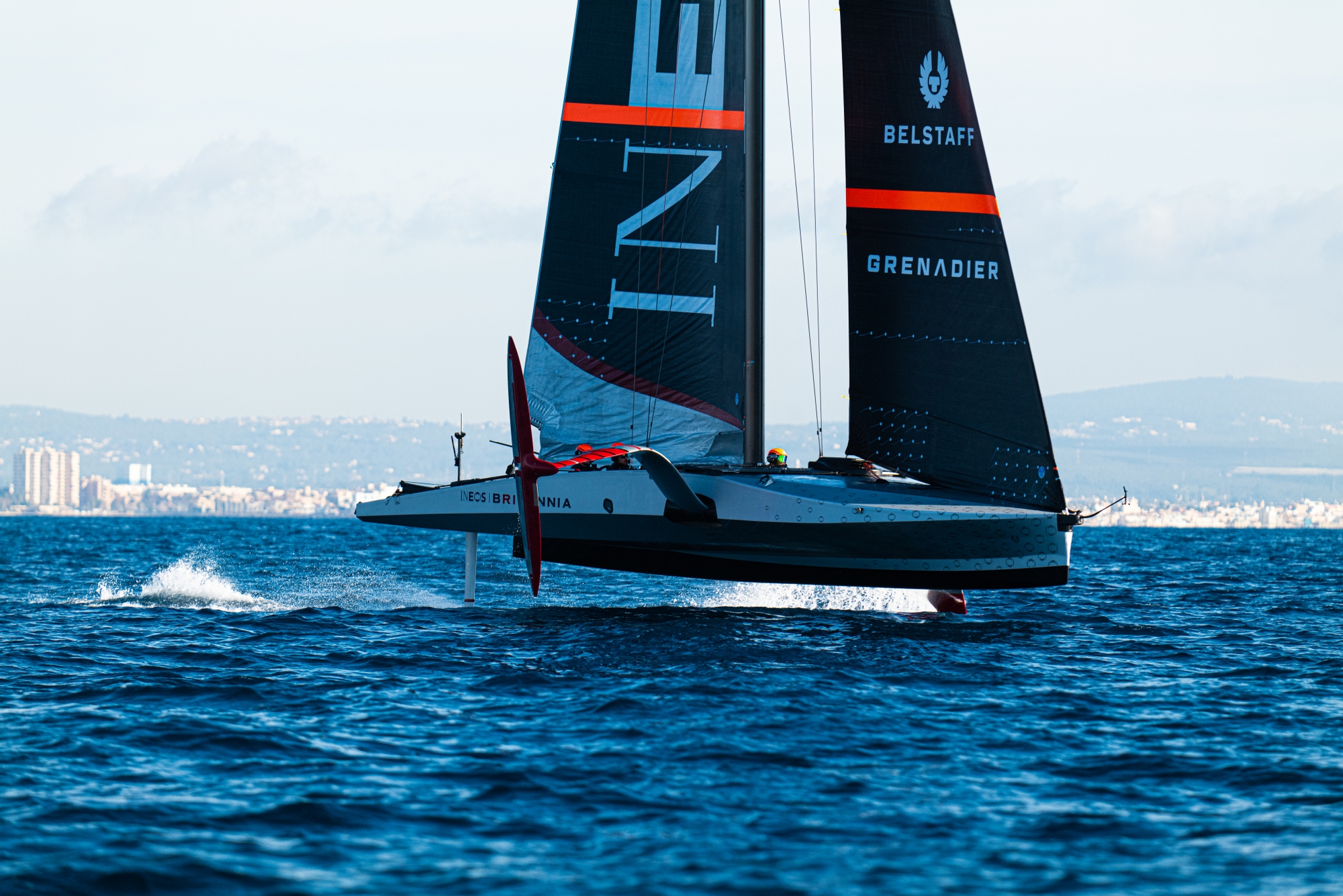
Some interesting technology and thinking was being deployed today around the clew area with a rod positioned at a downward angle that ran from the mainsheet ram to around 5 feet forward into the foot of the boomless mainsail. This appears to be a key area for the teams and as we saw today on American Magic, even more radical solutions are being adopted to bring drive and control into this lower quarter area towards the clew. The T6 solution looked highly effective in promoting, inducing power as well as de-powering almost immediately post take-off.
On some of the faster downwind runs towards the end of the day, and with confidence oozing from the sailors, it was noticeable that the Flight Controllers were experimenting with ride height in the choppy conditions that sported swells just under a metre and at a high frequency. The British controlled it beautifully and even threw in an impressive foil-to-foil gybe for good measure but a dramatic (from the recon unit’s perspective) splashdown right towards the end of the afternoon replete with the usual plumes of Spanish spray, appeared to be the signal to call it a day and the chase team towed T6 back to harbour. No harm done.
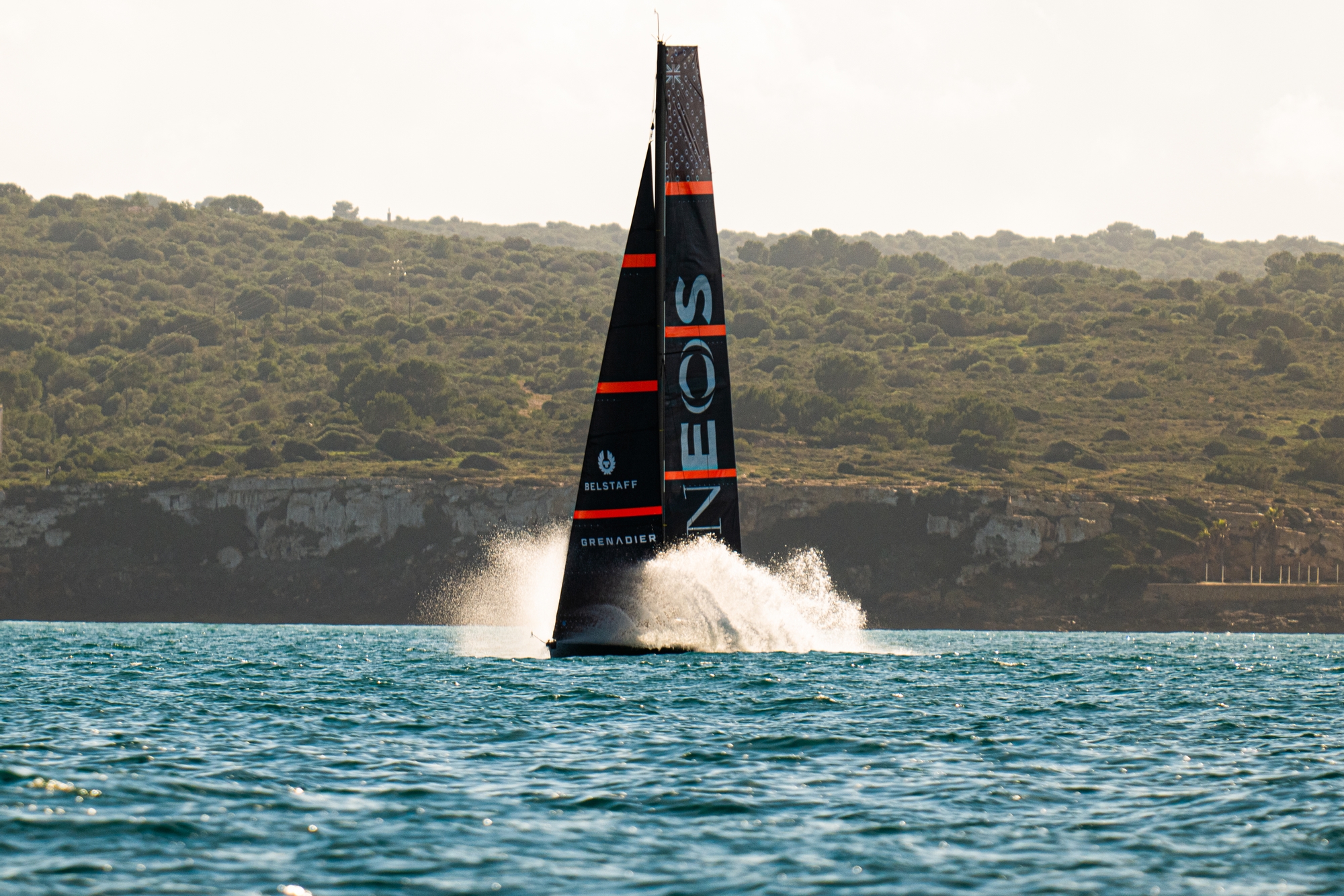
Speaking afterwards Giles Scott, one of the AC stars certain to enjoy a very high profile in Barcelona due to his candour and openness summarised, saying: “The boat’s all good…I'm sure there will be a long list of checks that the guys will like to do in the shed but the boat’s fine…we got out early today, we had a good two or three hours and we ticked off a good few items.”
INEOS Britannia is scheduled to be back on the water tomorrow - the programme is quite definitely on track and delivering now. (Magnus Wheatley)
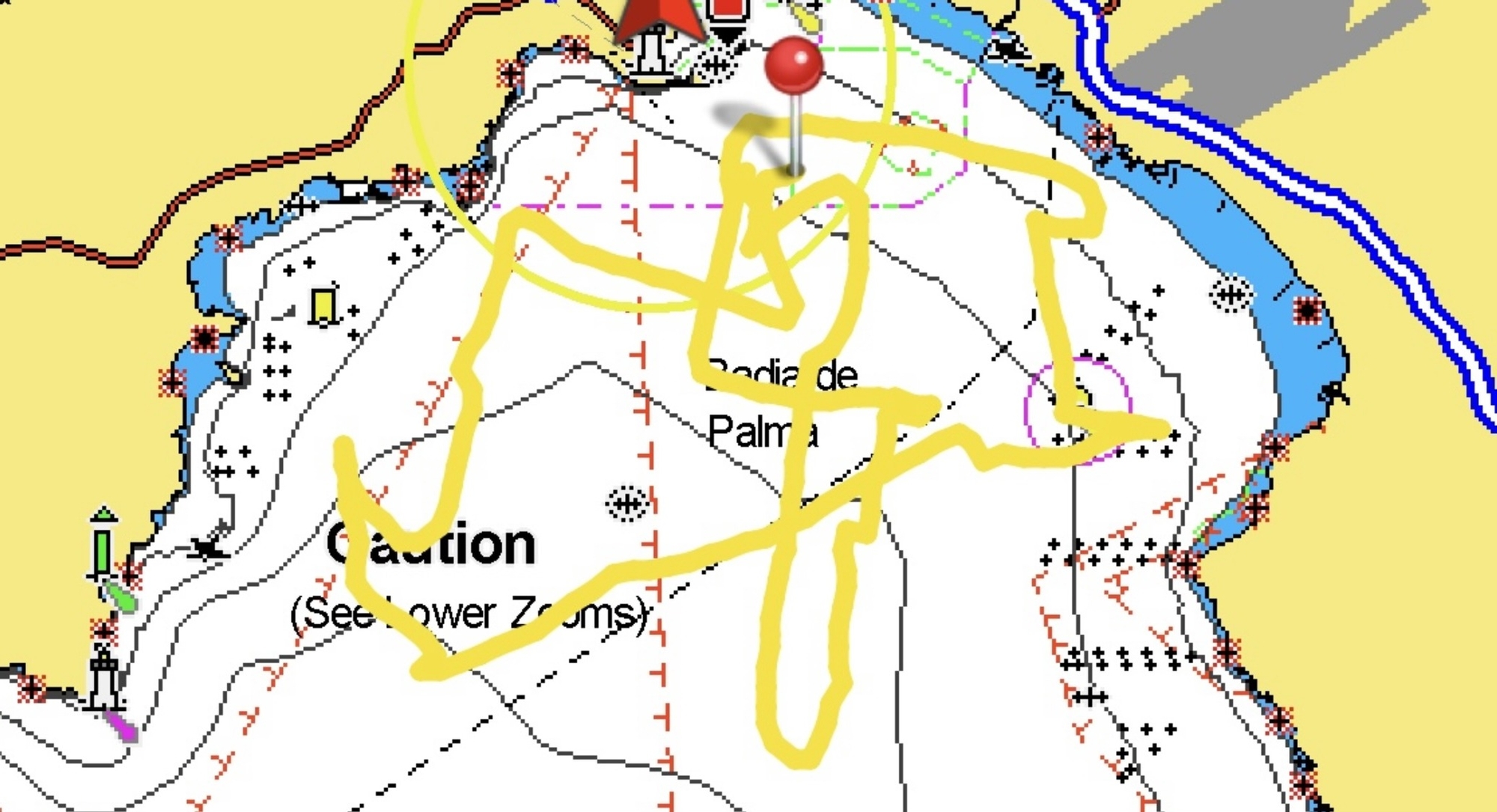
On-Water Recon Unit Notes: Despite a forecast of sub 10 knot winds for the day in Palma the British team appeared keen to get on the water as early as possible after calling for an 0800 rollout of its T6 LEQ12. Less than an hour later the mast was set up and the boat craned into the water in ultra-light winds and mirror flat conditions.
Outside the harbour the wind was similarly light, necessitating a slow side-tow out to the south in search of the slowly building southerly breeze. Once well offshore the breeze built quickly to a solid 12 - 13 knots, although – after just a couple of self-foiling runs in the west side of the Bay of Palma – the breeze became patchy and unstable in that area and the boat was towed on two foils all the way over to the east side of the Bay where the breeze had filled in properly from around 220 degrees.
Once again, the same crew from the previous day – helmsmen Giles Scott and Ben Cornish, with trimmers/flight controllers Leigh McMillan and Bleddyn Mon – seemed comfortable to push the boat a little harder still. They racked up around 41 kilometres of sailing over the day, with multiple foiling runs that took them the length and the breadth of Palma Bay’s eastern section – including a spectacular fast fly-by of a fleet of Laser sailors out on a mid-bay training session.
The runs featured plenty of stable fast flying, as well as many skimming touchdowns, and a handful of major splashdowns. Following one of these splashdowns, shortly before 1400 (see end of highlights video) the boat stopped head to wind, and after a 10 minute wait the sails were dropped and the tow home began.
In our interview with Giles Scott he said there had been no damage to the boat but expected the shore crew to have a long list of items to check off tonight. None of those items can have been too serious as the team has called for another sailing day tomorrow.
Dock out: 1200 Dock-in: 1700
Onboard Today
Helms: Giles Scott / Ben Cornish
Crew: Leigh MacMillan / Bleddyn Mon
Sails Used:
M1-1 Mainsail: 3 hours
J1-1: 3 hours
Total Tacks: 4 - 4 touchdowns
Total Gybes: 3 – 3 touch & go
Multiple foiling runs in the stronger northerly breeze on flat water – lasting between 1 and 5 minutes. Top speed estimated to be 35 knots +
Wind Strength: AM 0 - 2 knots for rigging and launch. PM Outside harbour Initial 3 - 5 knots building steadily to 12 - 13 knots peak. Clear blue skies, 18 degrees. Moderate swell up to 0.75 metre
Take-off speed: 12-13 knots (estimate)
All foiling runs were self-take off – typically at an estimated 12 - 13 knots


